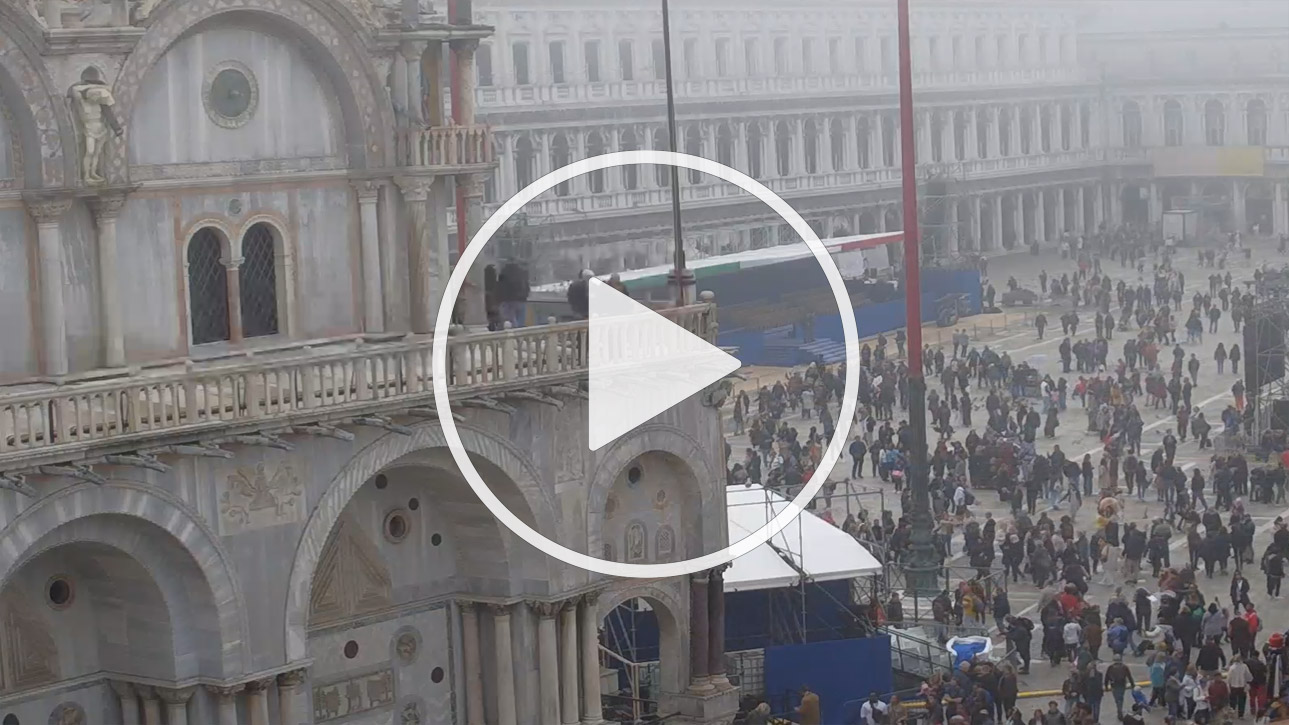Piazza San Marco Live Cam
High water (Acqua Alta) observation cam

The Rich History of Piazza San Marco: Heart of Venice
Piazza San Marco, commonly known as St. Mark's Square, has served as the social, religious, and political center of Venice since its inception in the 9th century. Originally a small space centered around St. Mark's Basilica, the Piazza expanded significantly in the 12th century under Doge Sebastiano Ziani's influence. Known as one of Europe’s most celebrated squares, Piazza San Marco has witnessed the rise and fall of the Venetian Republic, the grandeur of imperial celebrations, and even the dramatic occupation by Napoleon Bonaparte, who famously referred to it as the “Drawing Room of Europe.”
Architectural Landmarks of Piazza San Marco
Among the most iconic structures in Piazza San Marco is St. Mark's Basilica, a symbol of Venetian wealth and artistic achievement. Built in the Byzantine style and adorned with mosaics, gold leaf, and marble, the Basilica houses the relics of St. Mark the Evangelist, Venice’s patron saint. Adjacent to the Basilica is the Campanile di San Marco, or St. Mark’s Campanile, a towering bell tower that stands 98.6 meters tall. Originally built as a lighthouse for sailors, it offers panoramic views of the Venetian lagoon and surrounding islands.
On the opposite side of the Piazza stands the Doge's Palace (Palazzo Ducale), an architectural masterpiece of Gothic and Renaissance styles. The palace served as the residence of the Doge and the seat of government. Known for its richly decorated rooms and famous Bridge of Sighs, it offers a glimpse into Venice’s past political power. Completing the square is the Procuratie, a series of three connected buildings with elegant arcades that once housed the offices of the Procurators of San Marco, influential officials second only to the Doge in power. Today, the Procuratie buildings house cafes, shops, and museums, creating a lively atmosphere around the square.
The Role of Piazza San Marco in Venetian Life and Culture
Piazza San Marco has always been a gathering point for Venetians and travelers alike. During the height of the Venetian Republic, it was a place of grand ceremonies, public gatherings, and even religious processions. The famous Carnevale di Venezia festival, known for its elaborate masks and costumes, brings a vibrant energy to the square each year, attracting visitors from around the world. Many historic cafes like Caffè Florian and Gran Caffè Quadri have served renowned figures, from Casanova to Lord Byron, adding to the square’s cultural significance.
Surrounding Sights: Beyond Piazza San Marco
While Piazza San Marco is Venice’s most celebrated public space, its surroundings offer equally mesmerizing sights. To the south of the square lies the Venetian Lagoon, an enchanting body of water that gives Venice its nickname, “The Floating City.” Nearby, the Isola di San Giorgio Maggiore, with its beautiful church designed by Andrea Palladio, provides an exceptional view of Piazza San Marco from across the lagoon. Accessible by a short vaporetto ride, San Giorgio Maggiore offers a quieter atmosphere and an alternative perspective of Venice's historic center.
The Rialto Bridge, Venice’s oldest bridge across the Grand Canal, is also a short walk from Piazza San Marco. This iconic structure is not only an architectural marvel but a bustling hub of activity, surrounded by markets selling fresh produce, fish, and Venetian crafts. Strolling along the canal’s edge, visitors can enjoy views of historic palazzos and observe gondoliers navigating Venice’s famous waterways.
Interesting Fact: The Ever-Sinking Piazza San Marco
Did you know that Piazza San Marco is one of the lowest points in Venice, and it frequently experiences flooding, known locally as acqua alta? During high tide, parts of the square can become submerged, creating an impressive mirror effect that draws photographers from around the globe. Elevated walkways are installed during these times to allow people to traverse the flooded areas, and recent engineering projects aim to protect Venice from further sinking.
Tip for Travelers: Discovering Venice’s Hidden Gems Near Piazza San Marco
A tip for those exploring beyond Piazza San Marco is to visit the nearby Mercerie, a series of narrow streets and alleys filled with boutiques, artisanal shops, and small cafes. This area connects Piazza San Marco with the Rialto and offers a glimpse into the daily life of Venetians. Additionally, for a serene escape, consider exploring Giardini Reali, the Royal Gardens located a few steps from the square, where you can enjoy a peaceful break amidst lush greenery and beautiful views of the lagoon.